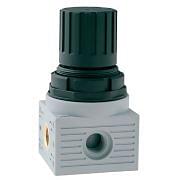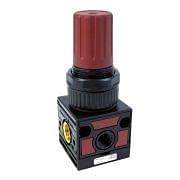Pressure regulators
In the beating heart of mechanical workshops, operational efficiency is everything. A key component in ensuring that everything runs smoothly is the pressure regulator. These often underestimated devices play a crucial role in managing fluid and gas pressure, ensuring that mechanical systems operate safely and optimally.
Pressure regulators are devices designed to maintain a constant pressure in a system, regardless of changes in pressure input or fluid consumption. They are essential to ensure that machinery and equipment operate correctly, avoiding overpressure that could damage components or cause malfunctions.
In machine shops, pressure regulators are used in a variety of applications, from compressed air to hydraulic systems. A common example is the use of pressure regulators for compressed air, which are essential for maintaining the right pressure in pneumatic tools. These tools require a specific pressure to function properly and a regulator ensures that this is always maintained, regardless of the compressor pressure.
Choosing the right pressure regulator depends on several factors, including the type of fluid (gas or liquid), the desired inlet and outlet pressure and the required flow. It is also important to consider compatibility with system materials and operating temperature.
Proper maintenance is essential to ensure the longevity and effectiveness of pressure regulators. This includes periodic checks, cleaning and replacement of worn parts. Preventive maintenance can avoid sudden failures and costly downtime.
The use of pressure regulators has many advantages, including:
- Safety: They prevent overpressure situations that can damage system components and pose a danger to workers.
- Efficiency: They maintain a constant pressure, ensuring that machinery operates at maximum capacity.
- Machinery life: By reducing wear and tear due to pressure fluctuations, they help to extend the life of components.
Answers to Frequently Asked Questions
1. Why is it important to maintain a constant pressure in a system?
Maintaining a constant pressure is essential to ensure the proper functioning of machinery and to prevent damage caused by overpressure or pressure fluctuations.
2. What are the signs of a malfunctioning pressure regulator?
Common signs include unexplained pressure variations, fluid leaks, strange noises and reduced performance of connected equipment.
3. Are pressure regulators compatible with all types of gases and liquids?
No, it is essential to choose a regulator that is compatible with the type of fluid used in the system, also considering temperature and materials of construction.
4. How often should I check my pressure regulators?
The frequency of checks depends on use and operating conditions, but a quarterly check is generally recommended for most applications.
In conclusion, pressure regulators are vital components in machine shops, helping to improve the safety, efficiency and durability of machinery. Choosing the right regulator and maintaining it correctly can make the difference between an efficient system and costly downtime.











